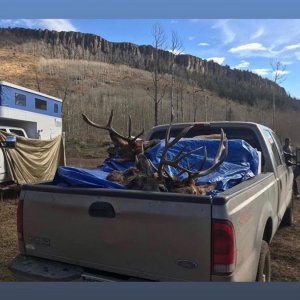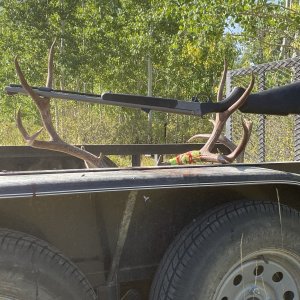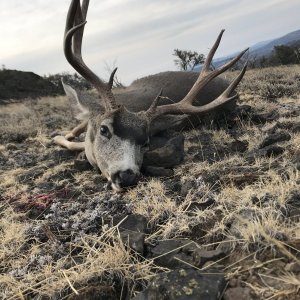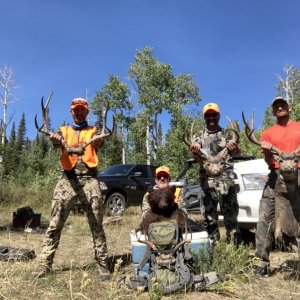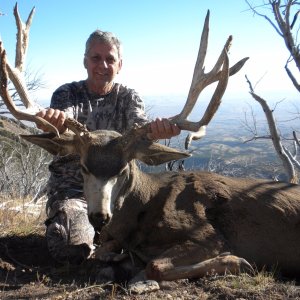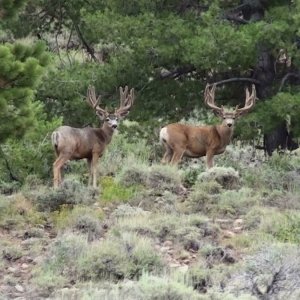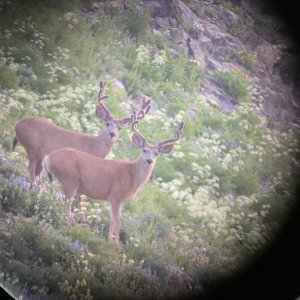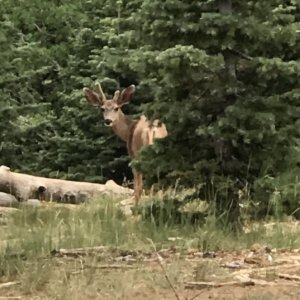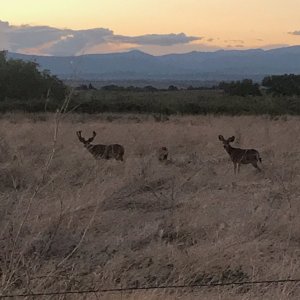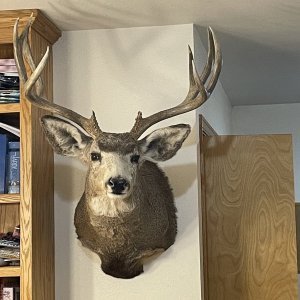R
rperkins
Guest
Attend a deer open house
Proposals that wildlife biologists will put together soon will affect the number of deer hunting permits that will be available in Utah this fall.
Mule deer
How many bucks per 100 does do you want to see the deer-hunting units in your region managed for?
But before they put their recommendations together, the biologists want to know how many bucks per 100 does you'd like to see the units in your region managed for.
To gather your thoughts, Division of Wildlife Resources biologists are holding a series of open houses across the state. The open house for the Northern Region was held Feb. 13. Here's where and when open houses will be held across the rest of Utah:
Southern Region
Feb. 15 ? DWR field office in Washington County (451 N. SR-318 at Quail Creek Reservoir), from 5 to 7 p.m.
Feb. 22 ? Sevier County Administration Building in Richfield (250 N. Main St), from 5 to 7 p.m.
Northeastern Region
Feb. 15 ? The Bingham Entrepreneurship and Energy Research Center in Vernal (320 N. 2000 W., on the USU campus), from 6:30 to 8 p.m.
Southeastern Region
Feb. 16 ? DWR office in Price (319 N. Carbonville Road), from 6 to 8 p.m.
Feb. 21 ? Grand Center in Moab (182 N. 500 W.), from 6 to 8 p.m.
Central Region
Feb. 23 ? DWR office in Salt Lake City (1594 W. North Temple), from 6 to 8 p.m.
Feb. 28 ? DWR office in Springville (1115 N. Main St., in the Conference Center), from 7 to 8:30 p.m.
Email
If you can't attend an open house, or the open house you want to attend has already been held, you have until Feb. 29 to send your comments via email to the following DWR staff:
Northern Region
Send ideas and comments to [email protected]his e-mail address is being protected from spambots. You need JavaScript enabled to view it or Wildlife Manager Randy Wood at [email protected]his e-mail address is being protected from spambots. You need JavaScript enabled to view it . This region oversees the following units:
* Unit #1 ? Box Elder
* Unit #2 ? Cache
* Unit #3 ? Ogden
* Unit #4/5/6 ? Chalk Creek/East Canyon/Morgan-South Rich
* Unit #7 ? Kamas
* Unit #8 ? North Slope (management shared with the Northeastern Regional Office)
Northeastern Region
Send ideas and comments to Wildlife Manager Charles Greenwood at [email protected]his e-mail address is being protected from spambots. You need JavaScript enabled to view it . This region oversees the following units:
* Unit #8 ? North Slope (management shared with the Northern Regional Office)
* Unit #9A ? South Slope, Yellowstone
* Unit #9B/9D ? South Slope, Bonanza/Vernal
* Unit #17B/17C ? Wasatch Mtns, Avintaquin/Currant Creek
* Unit #11 ? Nine Mile (management shared with the Southeastern Regional Office)
Southeastern Region
Send ideas and comments to Wildlife Manager Justin Shannon at [email protected]his e-mail address is being protected from spambots. You need JavaScript enabled to view it . This region oversees the following units:
* Unit #11 ? North Slope (management shared with the Northeastern Region)
* Unit #12/16B/16C ? Central Mtns, Manti/San Rafael
* Unit #13A ? La Sal, La Sal Mtns
* Unit #14A ? San Juan, Abajo Mtns
Central Region
Send ideas and comments to Wildlife Manager Craig Clyde at [email protected]his e-mail address is being protected from spambots. You need JavaScript enabled to view it . This region oversees the following units:
* Unit #16A ? Central Mtns, Nebo
* Unit #17A ? Wasatch Mtns, West
* Unit #18 ? Oquirrh-Stansbury
* Unit #19A ? West Desert, West
* Unit #19C ? West Desert, Tintic
Southern Region
Send ideas and comments to Wildlife Manager Teresa Griffin at [email protected]his e-mail address is being protected from spambots. You need JavaScript enabled to view it . This region oversees the following units:
* Unit #20 ? Southwest Desert
* Unit #21A ? Fillmore, Oak Creek
* Unit #21B ? Fillmore, Pahvant
* Unit #22 ? Beaver
* Unit #23 ? Monroe
* Unit #24 ? Mt Dutton
* Unit #25A ? Plateau, Fishlake
* Unit #25B ? Plateau, Thousand Lakes
* Unit #25C/26 ? Plateau, Boulder/Kaiparowits
* Unit #28 ? Panguitch Lake
* Unit #29 ? Zion
* Unit #30 ? Pine Valley
Bucks per 100 does
The number of bucks per 100 does that you'd like to see on each unit in your region is the major item DWR biologists want to know about.
The number of bucks per 100 does is called a buck-to-doe ratio. Each of Utah's 30 deer hunting units will have one. This ratio is important because it determines two things: the number of bucks per 100 does that will be available on that unit and the number of permits that can be offered to hunt the unit.
The best way to increase the number of bucks per 100 does is to limit the number of bucks that are taken during the hunting season.
* Units that have a high buck-to-doe ratio provide hunters with more bucks but fewer opportunities to hunt.
* Units that have lower buck-to-doe-ratios provide fewer bucks per 100 does but more opportunities to hunt.
The Utah Wildlife Board has given DWR biologists some flexibility. Anis Aoude, big game coordinator for the DWR, says not every unit has to have an objective of 18 to 25 bucks per 100 does. "Having a lower buck-to-doe ratio on some units means more hunters can hunt those units," he says.
Proposals that wildlife biologists will put together soon will affect the number of deer hunting permits that will be available in Utah this fall.
Mule deer
How many bucks per 100 does do you want to see the deer-hunting units in your region managed for?
But before they put their recommendations together, the biologists want to know how many bucks per 100 does you'd like to see the units in your region managed for.
To gather your thoughts, Division of Wildlife Resources biologists are holding a series of open houses across the state. The open house for the Northern Region was held Feb. 13. Here's where and when open houses will be held across the rest of Utah:
Southern Region
Feb. 15 ? DWR field office in Washington County (451 N. SR-318 at Quail Creek Reservoir), from 5 to 7 p.m.
Feb. 22 ? Sevier County Administration Building in Richfield (250 N. Main St), from 5 to 7 p.m.
Northeastern Region
Feb. 15 ? The Bingham Entrepreneurship and Energy Research Center in Vernal (320 N. 2000 W., on the USU campus), from 6:30 to 8 p.m.
Southeastern Region
Feb. 16 ? DWR office in Price (319 N. Carbonville Road), from 6 to 8 p.m.
Feb. 21 ? Grand Center in Moab (182 N. 500 W.), from 6 to 8 p.m.
Central Region
Feb. 23 ? DWR office in Salt Lake City (1594 W. North Temple), from 6 to 8 p.m.
Feb. 28 ? DWR office in Springville (1115 N. Main St., in the Conference Center), from 7 to 8:30 p.m.
If you can't attend an open house, or the open house you want to attend has already been held, you have until Feb. 29 to send your comments via email to the following DWR staff:
Northern Region
Send ideas and comments to [email protected]his e-mail address is being protected from spambots. You need JavaScript enabled to view it or Wildlife Manager Randy Wood at [email protected]his e-mail address is being protected from spambots. You need JavaScript enabled to view it . This region oversees the following units:
* Unit #1 ? Box Elder
* Unit #2 ? Cache
* Unit #3 ? Ogden
* Unit #4/5/6 ? Chalk Creek/East Canyon/Morgan-South Rich
* Unit #7 ? Kamas
* Unit #8 ? North Slope (management shared with the Northeastern Regional Office)
Northeastern Region
Send ideas and comments to Wildlife Manager Charles Greenwood at [email protected]his e-mail address is being protected from spambots. You need JavaScript enabled to view it . This region oversees the following units:
* Unit #8 ? North Slope (management shared with the Northern Regional Office)
* Unit #9A ? South Slope, Yellowstone
* Unit #9B/9D ? South Slope, Bonanza/Vernal
* Unit #17B/17C ? Wasatch Mtns, Avintaquin/Currant Creek
* Unit #11 ? Nine Mile (management shared with the Southeastern Regional Office)
Southeastern Region
Send ideas and comments to Wildlife Manager Justin Shannon at [email protected]his e-mail address is being protected from spambots. You need JavaScript enabled to view it . This region oversees the following units:
* Unit #11 ? North Slope (management shared with the Northeastern Region)
* Unit #12/16B/16C ? Central Mtns, Manti/San Rafael
* Unit #13A ? La Sal, La Sal Mtns
* Unit #14A ? San Juan, Abajo Mtns
Central Region
Send ideas and comments to Wildlife Manager Craig Clyde at [email protected]his e-mail address is being protected from spambots. You need JavaScript enabled to view it . This region oversees the following units:
* Unit #16A ? Central Mtns, Nebo
* Unit #17A ? Wasatch Mtns, West
* Unit #18 ? Oquirrh-Stansbury
* Unit #19A ? West Desert, West
* Unit #19C ? West Desert, Tintic
Southern Region
Send ideas and comments to Wildlife Manager Teresa Griffin at [email protected]his e-mail address is being protected from spambots. You need JavaScript enabled to view it . This region oversees the following units:
* Unit #20 ? Southwest Desert
* Unit #21A ? Fillmore, Oak Creek
* Unit #21B ? Fillmore, Pahvant
* Unit #22 ? Beaver
* Unit #23 ? Monroe
* Unit #24 ? Mt Dutton
* Unit #25A ? Plateau, Fishlake
* Unit #25B ? Plateau, Thousand Lakes
* Unit #25C/26 ? Plateau, Boulder/Kaiparowits
* Unit #28 ? Panguitch Lake
* Unit #29 ? Zion
* Unit #30 ? Pine Valley
Bucks per 100 does
The number of bucks per 100 does that you'd like to see on each unit in your region is the major item DWR biologists want to know about.
The number of bucks per 100 does is called a buck-to-doe ratio. Each of Utah's 30 deer hunting units will have one. This ratio is important because it determines two things: the number of bucks per 100 does that will be available on that unit and the number of permits that can be offered to hunt the unit.
The best way to increase the number of bucks per 100 does is to limit the number of bucks that are taken during the hunting season.
* Units that have a high buck-to-doe ratio provide hunters with more bucks but fewer opportunities to hunt.
* Units that have lower buck-to-doe-ratios provide fewer bucks per 100 does but more opportunities to hunt.
The Utah Wildlife Board has given DWR biologists some flexibility. Anis Aoude, big game coordinator for the DWR, says not every unit has to have an objective of 18 to 25 bucks per 100 does. "Having a lower buck-to-doe ratio on some units means more hunters can hunt those units," he says.

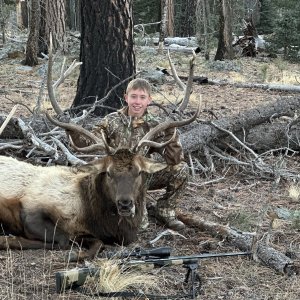
![IMG_6842(2)[1].jpg](/xf/data/xfmg/thumbnail/20/20277-688aadbffbb3890c9272ef30e321beea.jpg?1639069947)
